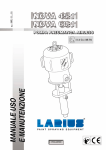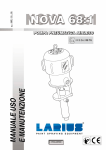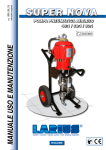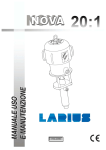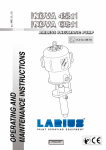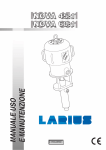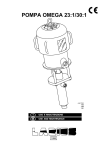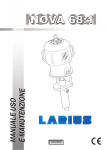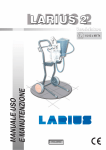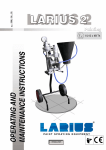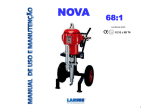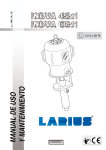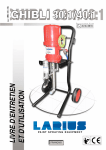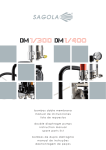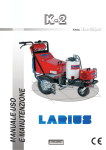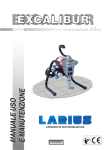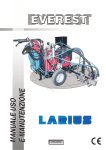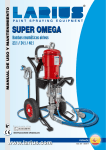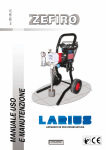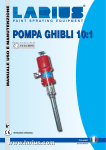Download manuale uso e manutenzione manuale uso e manutenzione
Transcript
MANUALE USO E MANUTENZIONE II 2 G c IIB T6 ITALIANO Ed. 006 03 - 10 NOVA 45:1/60:1 Italiano POMPE PNEUMATICHE AIRLESS PER VERNICIATURA N O P Q INTRODUZIONE........................................................p.1 A B C D E F G H I L M PRINCIPIO DI FUNZIONAMENTO.....................p.2 Dati tecnici......................................................p.2 DESCRIZIONE DELL’APPARECCHIATURA.......p.4 DESCRIZIONE PER AREE ESPLOSIVE............p.9 SMONTAGGIO DEL MOTORE PNEUMATICO...p.12 SMONTAGGIO DEL GRUPPO POMPANTE.......p.17 ESPLOSO GRUPPO POMPANTE IN TRASPORTO E DISIMBALLAGGIO....................p.5 ACCIAIO INOX....................................................p.20 NORME DI SICUREZZA.....................................p.5 INSTALLAZIONE TIPICA.....................................p.6 R ESPLOSO GRUPPO MOTORE..........................p.22 S ESPLOSO GRUPPO POMPANTE IN ACCIAIO MESSA A PUNTO...............................................p.7 AL CARBONIO....................................................p.24 T U V Z FUNZIONAMENTO.............................................p.7 PULIZIA DI FINE LAVORO..................................p.8 MANUTENZIONE ORDINARIA...........................p.8 INCONVENIENTI E RIMEDI...............................p.9 Leggere attentamente questo manuale prima di usare l'apparecchiatura. Un uso improprio può causare danni a cose e persone. Segnala il rischio di un infortunio o danno grave all'apparecchiatura se non viene seguito l'avvertimento. Segnala il rischio di incendio o di esplosione se non viene seguito l'avvertimento. ESPLOSO FILTRO DI LINEA ALTA PRESSIONE...p.26 CARRELLO COMPLETO....................................p.28 GRUPPO COMPLETO ARIA . ............................p.29 ACCESSORI.......................................................p.30 Segnala il rischio di lesioni e schiacciamenti alle dita per la presenza di parti mobili nell'apparecchiatura Segnalano la necessità di utilizzare particolari accessori come guanti, occhiali, maschere e cuffie di protezione per la sicurezza dell'operatore. QUESTA APPARECCHIATURA É AD USO ESCLUSIVAMENTE PROFESSIONALE. NON É PREVISTA PER UN UTILIZZO DIVERSO DA QUELLO DESCRITTO IN QUESTO MANUALE. Grazie per aver scelto un prodotto LARIUS s.r.l. Unitamente all'articolo acquistato riceverete una gamma di servizi di assistenza per consentirVi di raggiungere i risultati desiderati, velocemente ed in modo professionale. 1 Segnala importanti indicazioni e consigli per lo smaltimento o il riciclaggio di un prodotto nel rispetto dell'ambiente. Italiano NOVA 45:1/60:1 A PRINCIPIO DI FUNZIONAMENTO La pompa NOVA 45:1 (o 60:1) è una pompa pneumatica da utilizzare nella verniciatura alta pressione senz'aria (Airless) o per il travaso di liquidi dove è necessario alimentare più stazioni di utilizzo. È essenzialmente costituita da un motore ad aria e da una struttura definita «gruppo pompaggio materiale» o più semplicemente «gruppo pompante». Nel motore pneumatico l'aria compressa genera il movimento verticale alternativo del pistone motore; questo movimento viene trasmesso tramite un asta di collegamento al pistone del pompante materiale. Ciò fa sì che la pompa aspiri il materiale e lo spinga verso l'uscita. Il rapporto 45:1 (o 60:1) sta ad indicare che la pressione di uscita del materiale è 45 (o 60) volte la pressione dell'aria di alimentazione della pompa. B DATI TECNICI NOVA 45:1 NOVA 60:1 PRESSIONE ARIA DI ALIMENTAZIONE POMPA 3-7 bar (40-90 psi) 3-7 bar (40-90 psi) PRESSIONE MASSIMA DEL PRODOTTO 270 bar (3900 psi) 360 bar (5200 psi) 3/4" GAS (M) 3/4" GAS (M) 14 l/min (3,7 gpm) 12 l/min (3,2 gpm) NUMERO DI CICLI PER LITRO 4 5 MASSIMO N° DI CICLI AL MINUTO 60 60 1" GAS conico (F) 1" GAS conico (F) 57 kg 57 kg <90 dB (A) <90 dB (A) 1110 mm 1110 mm INGRESSO ARIA DI ALIMENTAZIONE PORTATA MASSIMA USCITA MATERIALE PESO LIVELLO DELLA PRESSIONE SONORA ALTEZZA TOTALE Parti della pompa a contatto del materiale Gruppo pompante: acciaio al carbonio zincato e ghisa o acciaio inox AISI 303 e 420B Sfere di tenuta: acciaio inox AISI 420B Guarnizioni: teflon oppure gomma nitrile o delrin o vulkollan Tenere ben presente queste note quando si deve valutare la compatibilità di un prodotto da utilizzare e quando si vuole procedere all'eliminazione di uno o più particolari della pompa non più utilizzabili, ai fini di programmare il riciclaggio dei singoli componenti nel rispetto dell'ambiente. Altri parti della pompa Supporto e cilindro motore pneumatico: alluminio Copertura: lamiera FE37 Pistone motore e supporto spingi rullo: ghisa 2 NOVA 45:1/60:1 Italiano 530 240 1110 580 87 150 100 4000 160 3500 140 3000 120 2500 100 2000 80 1500 60 1000 40 50 300 4000 3200 2400 1600 800 500 0 BAR L/MIN 0 0 240 180 120 2 5 3 10 4 15 5 GPM 20 0 0 0 CFM 4800 120 4200 105 3600 90 3000 75 2400 60 1800 45 1200 30 600 15 L/MIN 60 20 1 PSI L/MIN 2400 1800 1200 600 0 0 PORTATA POMPA 3000 CONSUMO D'ARIA 200 CFM PRESSIONE USCITA MATERIALE PRESSIONE USCITA MATERIALE 250 PSI CONSUMO D'ARIA BAR 1 2 5 3 10 4 15 5 GPM 20 0 0 L/MIN PORTATA POMPA 7 bar (100 psi) 5 bar (70 psi) 3 bar (40 psi) Curva nera: pressione uscita materiale Curva grigia: consumo aria La pompa può funzionare in continuità quando la portata è limitata alla zona bianca. Fuori da questa zona la velocità deve essere intermittente. 3 Italiano NOVA 45:1/60:1 C DESCRIZIONE DELL'APPARECCHIATURA 1 6 2 5 3 4 POS. POS. Descrizione Descrizione 1 Ingresso aria di alimentazione pompa 4 Entrata materiale 2 Motore pneumatico 5 Gruppo pompante materiale 3 Uscita materiale 6 Golfare per trasporto pompa 4 NOVA 45:1/60:1 Italiano D TRASPORTO E DISIMBALLAGGIO • Rispettare scrupolosamente l'orientamento dell'imballaggio indicato esternamente da scritte o simboli. • Prima di installare l'apparecchiatura, si predisponga un ambiente idoneo con lo spazio necessario, la corretta illuminazione, la pavimentazione pulita e liscia. IL COMPORTAMENTO DEL PERSONALE D OVRÀ RISPETTARE SCRUPOLOSAMENTE LE NORME ANTINFORTUNISTICHE DEL PAESE IN CUI È INSTALLATA L'APPARECCHIATURA OLTRE CHE LE NORME IN MATERIA DI INQUINAMENTO AMBIENTALE Leggere attentamente ed integralmente le seguenti istruzioni prima di utilizzare il prodotto. Custodire con cura le istruzioni. • Tutte le operazioni di scarico e movimentazione dell'apparecchiatura sono di pertinenza dell'utilizzatore che dovrà fare molta attenzione per evitare di provocare danni alle persone o all'apparecchiatura. Per l'operazione di scarico si utilizzi del personale specializzato ed abilitato (carrellisti, gruisti ecc.) ed un mezzo di sollevamento idoneo che abbia portata adeguata al peso dell'imballo e si rispettino tutte le norme di sicurezza. Il personale dovrà essere dotato delle necessarie protezioni individuali. La manomissione o la sostituzione non autorizzata di una o più parti che compongono l'apparecchiatura, l'uso di accessori, di utensili, di materiali di consumo diversi da quelli raccomandati dal costruttore, possono rappresentare pericolo di infortunio e sollevano il costruttore da responsabilità civili e penali. • TENERE IN ORDINE L'AREA DI LAVORO. DISORDINE SUL POSTO DI LAVORO COMPORTA PERICOLO DI INCIDENTI. • MANTENERE SEMPRE UN BUON EQUILIBRIO EVITANDO POSIZIONI MALSICURE. • Verificare l'integrità dell'imballo all'atto del ricevimento. Togliere l'apparecchiatura dall'imballo e controllare che non abbia subito danni durante il trasporto. Qualora si riscontrassero componenti danneggiati, contattare tempestivamente la LARIUS e l'Agente di trasporto. Il termine massimo per le comunicazioni di danneggiamento è di 8 giorni dalla data di ricevimento dell'apparecchiatura. La comunicazione dovrà avvenire tramite raccomandata con ricevuta di ritorno indirizzata alla LARIUS ed al trasportatore. • PRIMA DELL'UTILIZZO CONTROLLARE SCRUPOLOSAMENTE CHE NON VI SIANO PARTI DANNEGGIATE E CHE L'APPARECCHIATURA SIA IN GRADO DI EFFETTUARE IL SUO LAVORO IN MODO CORRETTO. • OSSERVARE SEMPRE LE ISTRUZIONI PER LA SICUREZZA E LE NORMATIVE VIGENTI. • NON PERMETTERE CHE PERSONE ESTRANEE POSSANO ACCEDERE ALL’AREA DI LAVORO. • NON SUPERARE MAI LE PRESSIONI MASSIME DI ESERCIZIO INDICATE. • Lo smaltimento dei materiali di imballaggio, a carico dell'utilizzatore, dovrà essere eseguito in conformità alle normative vigenti nel paese di utilizzo dell'apparecchiatura. É comunque buon comportamento riciclare il più possibile in modo ecologico i materiali dell'imballaggio. • NON DIRIGERE MAI LA PISTOLA VERSO SE STESSI O ALTRE PERSONE. IL CONTATTO CON IL GETTO PUÒ CAUSARE SERIE FERITE. • IN CASO DI FERITE PROCURATE DAL GETTO DELLA PISTOLA RICORRERE SUBITO ALLE CURE DI UN MEDICO SPECIFICANDO IL TIPO DI PRODOTTO INIETTATO. NON SOTTOVALUTARE MAI UNA LESIONE PROCURATA DALL’INIEZIONE DI UN FLUIDO. • TOGLIERE SEMPRE L’ALIMENTAZIONE ELETTRICA E SCARICARE LA PRESSIONE NEL CIRCUITO PRIMA DI EFFETTUARE QUALSIASI TIPO DI CONTROLLO O DI SOSTITUZIONE DEI PARTICOLARI DELL’APPAREC-CHIATURA. • NON MODIFICARE MAI NESSUN PARTICOLARE DELL’APPARECCHIATURA. VERIFICA REGOLARMENTE I COMPONENTI DEL SISTEMA.SOSTITUIRE I PARTICOLARI DANNEGGIATI O USURATI. • STRINGERE E CONTROLLARE TUTTI I RACCORDI DI • Il costruttore declina ogni responsabilità relativa allo scarico ed al trasporto dell'apparecchiatura sul luogo di lavoro. E NORME DI SICUREZZA • IL DATORE DI LAVORO DOVRÀ PROVVEDERE AD ISTRUIRE IL PERSONALE SUI RISCHI DI INFORTUNI, SUI DISPOSITIVI DI SICUREZZA DELL'OPERATORE E SULLE REGOLE ANTINFORTUNISTICHE GENERALI PREVISTE DALLE DIRETTIVE INTERNAZIONALI E DELLA LEGISLAZIONE DEL PAESE IN CUI È INSTALLATA L'APPARECCHIATURA OLTRE CHE LE NORME IN MATERIA DI INQUINAMENTO AMBIENTALE. 5 Italiano NOVA 45:1/60:1 COLLEGAMENTO TRA LA POMPA, IL TUBO FLESSIBILE E LA PISTOLA PRIMA DI UTILIZZARE L’APPARECCHIATURA. • UTILIZZARE SEMPRE IL TUBO FLESSIBILE PREVISTO NEL CORREDO STANDARD DI LAVORO. L'IMPIEGO DI ACCESSORI O ATTREZZATURA DIVERSI DA QUELLI RACCOMANDATI NEL PRESENTE MANUALE PUÒ ESSERE CAUSA DI INFORTUNI. • PRENDERE APPROPRIATE MISURE DI PROTEZIONE DELL’UDITO SE SI LAVORA NELLE IMMEDIATE VICINANZE DELL’APPARECCHIATURA. Dopo alcuni minuti di funzionamento, la superficie metallica superiore dell’apparecchiatura raggiunge una temperatura molto bassa. Evitare di toccare la zona indicata. Il contatto della pelle con la zona a bassa temperatura può causare congelamento. Indumenti comuni di lavoro e guanti (di cuoio) forniscono una protezione adeguata. IL FLUIDO CONTENUTO NEL TUBO FLESSIBILE PUÒ ESSERE MOLTO PERICOLOSO. MANEGGIARE CON CURA IL TUBO FLESSIBILE. NON TIRARE IL TUBO FLESSIBILE PER SPOSTARE L’APPARECCHIATURA. NON UTILIZZARE MAI UN TUBO FLESSIBILE DANNEGGIATO O RIPARATO. L’elevata velocità di scorrimento del prodotto nel tubo flessibile può creare elettricità statica che si manifesta con piccole scariche e scintille. Si raccomanda di collegare a terra l’apparecchiatura. La pompa e’ collegata a terra dal filo di massa del cavo dell’alimentazione elettrica. La pistola e’ collegata a terra mediante il tubo alta pressione flessibile. Tutti gli oggetti conduttori che si trovano in prossimità della zona di lavoro devono essere collegati a terra. • EVITARE ASSOLUTAMENTE DI SPRUZZARE PRODOTTI INFIAMMABILI O SOLVENTI IN AMBIENTI CHIUSI. • EVITARE ASSOLUTAMENTE DI UTILIZZARE L’APPARECCHIATURA IN AMBIENTI SATURI DI GAS POTENZIALMENTE ESPLOSIVI. F INSTALLAZIONE TIPICA La pompa NOVA viene solitamente fornita già fissata su staffa per il fissaggio a parete oppure su carrello o su paranco pneumatico. Per il corretto fissaggio della pompa su altre strutture utilizzare i 4 fori posti sulla base del motore pneumatico (vedi figura per quote dimensionali). Verificare sempre la compatibilità del prodotto con i materiali che compongono l’apparecchiatura (pompa, pistola, tubo flessibile e accessori) con i quali può venire a contatto. Non utilizzare vernici o solventi che contengono idrocarburi alogenati (come il cloruro di metilene). Questi prodotti a contatto con parti in alluminio dell’apparecchiatura possono causare pericolose reazioni chimiche con rischio di esplosione. Ø266 * 45° 45° Evitare di avvicinarsi eccessivamente allo stelo pistone della pompa quando questa è in funzione o in pressione. Un movimento improvviso o brusco dello stelo pistone può provocare lesioni o schaicciamenti alle dita. Ø11 SE IL PRODOTTO DA UTILIZZARE E’ TOSSICO EVITARE L’INALAZIONE E IL CONTATTO UTILIZZANDO GUANTI PROTETTIVI, OCCHIALI DI PROTEZIONE E APPROPRIATE MASCHERE. Ø240 *Int. fori 6 NOVA 45:1/60:1 • Far affluire l'aria compressa alla pompa. Si consiglia di regolare la pressione dell'aria al valore minimo che è necessario al funzionamento della stessa in modo continuativo. FISSAGGIO DELLA POMPA SUL PARANCO Per il corretto fissaggio della pompa sul paranco seguire la procedura descritta nel manuale uso e manutenzione del paranco pneumatico. • La pompa si metterà in funzione e si arresterà quando tutta la camera del prodotto sarà piena. La pompa ricomincerà a funzionare ogni volta che verrà premuto il grilletto della pistola o aperta la valvola erogatrice. COLLEGAMENTO ALL'ARIA DI ALIMENTAZIONE Per l'alimentazione della pompa utilizzare un tubo avente un diametro interno non inferiore a 20 mm. • La pompa è stata collaudata in fabbrica con olio minerale leggero che può essere rimasto in parte all'interno del pompante. Puntare la pistola (H3) o la valvola erogatrice contro un recipiente di raccolta (H4) ed espellere il prodotto rimasto nella pompa fino a che non si veda uscire il materiale da utilizzare. Installare all'ingresso della pompa un regolatore di pressione dell'aria (si consiglia completo di filtro condensa e lubrificatore). La pressione di uscita del materiale è 45 volte (NOVA 45:1) o 60 volte (NOVA 60:1) la pressione d'ingresso dell'aria di alimentazione della pompa. Quindi è di fondamentale importanza poter regolare il valore della pressione dell'aria di alimentazione. H3 H4 COLLEGAMENTO DEL TUBO USCITA MATERIALE Collegare il tubo alta pressione all'uscita della pompa. Si raccomanda di serrare fortemente i raccordi. H fUNZIONAMENTO Controllare tutti i raccordi di collegamento dei diversi componenti (pompa, tubo flessibile, pistola, ecc.) prima di utilizzare l'apparecchiatura. • Immergere il tubo pompante materiale (H1) nel serbatoio del prodotto (H2) (se la pompa è fissata sul paranco pneumatico seguire la procedura descritta nel manuale uso e manutenzione del pneumatico). Evitare assolutamente di far funzionare la pompa a vuoto: questo potrebbe provocare seri danni al motore pneumatico e rovinare le guarnizioni di tenuta. • Se si prevedono delle lunghe pause durante l'utilizzo dell'apparecchio (ad esempio la pausa notturna alla fine della giornata lavorativa), accertarsi che il prodotto che si sta utilizzando può essere lasciato all'interno della pompa e delle varie tubature senza pericolo che secchi. Se questo rischio non sussiste, allora in caso di pausa lavorativa è sufficiente interrompere la fornitura di aria alla pompa e scaricare la pressione nel circuito agendo sulla valvola erogatrice oppure sulla valvola di spurgo della pompa. H1 H2 7 Italiano G MESSA A PUNTO Italiano NOVA 45:1/60:1 I PULIZIA DI FINE LAVORO Per pulizia di fine lavoro si intende la pulizia da effettuare qualora si volesse utilizzare un diverso prodotto oppure quando si prevede un lungo periodo di inattività dell'apparecchiatura. • Chiudere la fornitura d'aria alla pompa. • Immergere il tubo pompante materiale nel serbatoio del solvente di lavaggio (accertare la sua compatibilità chimica con il prodotto che si sta utilizzando). • Far affluire l'aria compressa alla pompa. Si consiglia di regolare la pressione dell'aria al valore minimo che è necessario al funzionamento della stessa in modo continuativo. • • A questo punto, chiudere la fornitura di aria alla pompa e scaricare la pressione residua. • Se si prevede un lungo periodo di inattività si consiglia di aspirare e lasciare all'interno del pompante olio minerale leggero. Conservare eventuali fluidi pericolosi in contenitori appropriati. Essi vanno eliminati in osservanza alle leggi relative allo smaltimento dei rifiuti industriali. Puntare la pistola o la valvola erogatrice contro un recipiente di raccolta ed espellere il prodotto rimasto nella pompa fino a che non si veda uscire del solvente pulito. L MANUTENZIONE ORDINARIA Chiudere sempre la fornitura di aria compressa e scaricare la pressione nell'impianto prima di effettuare qualsiasi tipo di controllo o di manutenzione sulla pompa. • Verificare periodicamente (e ogni volta che si avvia la pompa dopo un lungo periodo di inattività) che la ghiera premi guarnizioni non sia allentata provocando la fuoriuscita del prodotto. Per stringere la ghiera sollevare la tazza porta lubrificante (vedi figura sotto). Utilizzare la chiave in dotazione (rif. 11504). La ghiera deve essere stretta in modo da impedire perdite ma non eccessivamente per non causare il grippaggio del pistone pompante e l'usura eccessiva delle guarnizioni di tenuta. Se dovesse persistere perdita di prodotto procedere alla sostituzione delle guarnizioni. • Tenere riempita la tazza di liquido lubrificante (compatibile con il prodotto che si sta utilizzando) in modo da evitare che il prodotto secchi sullo stelo pistone. • Controllare periodicamente la linea di fornitura dell'aria alla pompa. Accertarsi che l'aria sia sempre ben pulita e lubrificata. Se sulla linea di fornitura dell'aria alla pompa è stato installato un lubrificatore si consiglia di tenere riempita la tazza dello stesso di una miscela di acqua e liquido antigelo (rapporto di diluzione 4:1). Tazza porta lubrificante Corona di rabbocco olio Chiave Rif. 11504 8 NOVA 45:1/60:1 Italiano M INCONVENIENTI E RIMEDI Causa Soluzione • L'aria di alimentazione è insufficiente; • Controllare la linea di fornitura dell'aria. Aumentare il diametro del tubo di alimentazione; • Pulire. Staccare il tubo di uscita del prodotto. Alimentare la pompa al minimo della pressione e verificare se senza il tubo di uscita la pompa parte; • Smontare il gruppo pompante e pulire; • Svitare il tappo e spingere in giù il corpo valvola. Utilizzare un'asta metallica e una mazzuola; • Smontare il motore e verificare; Problema • La pompa non entra in funzione • Linea di uscita del prodotto intasata; • • La pompa ha un funzionamento accelerato e non va in pressione • Prodotto seccato all'interno del pompante; Motore pneumatico bloccato nella posizione di inversione ciclo; • Rottura di particolari del motore pneumatico; • Manca il prodotto; • La pompa aspira aria; • • La pompa funziona ma c'è insufficiente uscita di prodotto • L'aria di alimentazione è insufficiente; Valvola di aspirazione usurata o parzialmente ostruita; • Valvola di uscita prodotto usurata o parzialmente ostruita; • Valvola di aspirazione usurata o parzialmente ostruita; • Linea di uscita del prodotto intasata; • La pressione dell'aria di alimentazione è troppo bassa; • Perdita di prodotto della tazza porta lubrificante • Guarnizioni superiori usurate. • Aggiungere il prodotto; • Aprire la valvola di spurgo. Per la versione sul paranco vedere le istruzioni contenute nel manuale relativo; • Aumentare la pressione dell'aria di alimentazione; • Smontare la valvola di aspirazione. Pulire e/o eventualmente sostituire i particolari usurati; • Smontare la valvola di uscita. Pulire e/o eventualmente sostituire i particolari usurati; • Smontare la valvola di aspirazione. Pulire e/o eventualmente sostituire i particolari usurati; • Pulire. Staccare il tubo di uscita del prodotto, alimentar e la pompa al minimo della pressione e verificare se senza il tubo di uscita la portata aumenta; • Aumentare la pressione dell'aria; • Stringere la ghiera premi guarnizioni. Se persiste perdita di prodotto sostituire le guarnizioni superiori del pompante. Chiudere sempre la fornitura di aria compressa e scaricare la pressione nell'impianto prima di effettuare qualsiasi tipo di controllo o sostituzione dei particolari della pompa. N DESCRIZIONE PER AREE ESPLOSIVE Queste istruzioni di sicurezza si riferiscono all’installazione, uso e manutenzione delle pompe pneumatiche a pistone per travaso LARIUS serie NOVA per l’utilizzo in aree potenzialmente esplosive con presenza di gas o vapori. Le pompe pneumatiche a pistone LARIUS serie NOVA sono apparecchiature meccaniche del gruppo II, per l'uso in zone classiche con presenza di gas IIB (categoria 2G). Esse sono progettate e costruite in accordo alla direttiva ATEX 94/9/CE, secondo le norme europee: EN 1127-1, EN 13463-1 ed EN 13463-5. Queste istruzioni devono essere osservate in aggiunta alle avvertenze riportate nel manuale d’uso e manutenzione. 9 CARATTERISTICHE TECNICHE Le principali caratteristiche delle pompe pneumatiche a pistone serie NOVA sono indicate nella tabella sotto riportata: Rapporto Pressione Ø Ingresso alimentazione aria Ø Ingresso materiale Ø Uscita materiale Pressione di lavoro max Portata max 20:1 3 ÷ 6 bar CG 3/4" Valvola sfera CG 1. 1/2" 120 bar 32 l/min 45:1 3 ÷ 6 bar CG 3/4" Valvola sfera CG 1. 1/2" 270 bar 14 l/min 55:1 3 ÷ 6 bar CG 3/4" Piattello CG 1" 330 bar 12 l/min 60:1 3 ÷ 6 bar CG 3/4" Valvola sfera CG 1" 360 bar 12 l/min 68:1 3 ÷ 6 bar CG 3/4" Valvola sfera CG 3/4" 410 bar 11 l/min • Temperatura ambiente: -20°C ÷ +60°C • Temperatura massima del fluido: 60°C • Numero massimo di cicli al minuto: 60 MARCATURA 3 Italiano NOVA 45:1/60:1 X II 2 G c IIB T6 • Tamb: -20°C ÷ + 60°C • Tmax. fluido: 60°C • Tech. File: NOVA/ATX/08 II = Gruppo II ( superficie) 2= Categoria 2 (zona 1) G= Atmosfera esplosiva con presenza di gas, vapori o nebbie c= Sicurezza costruttiva "c" T6 = Classe di temperatura T6 - 20°C ÷ + 60°C 60°C Temperatura ambiente Massima temperatura del fluido di processo xxxx/AA Numero di serie o numero di lotto (xxxx = PROGRESSIVO/ anno = AA) Corrispondenze tra zone pericolose, sostanze e categorie ZONA PERICOLOSA CATEGORIE SECONDO DIRETTIVA 94/9/CE Gas, vapori o nebbie Zona 0 1G Gas, vapori o nebbie Zona 1 2G oppure 1G Gas, vapori o nebbie Zona 2 3G, 2G oppure 1G 10 NOVA 45:1/60:1 ESEMPIO DI DICHIARAZIONE DI CONFORMITÀ Prima dell’installazione leggere attentamente quanto riportato nel manuale d’uso e manutenzione. Tutte le operazioni di manutenzione devono essere eseguite secondo quanto riportato nel manuale. • • • • • Larius S.r.l. Via Stoppani, 21 23801 Calolziocorte (LC) dichiariamo sotto la nostra esclusiva responsabilità che il prodotto: Il cavo di M.T. delle suddette pompe deve essere collegato a terra mediante apposito elemento di connessione antiallentante. Le tubazioni utilizzate per il collegamento mandata e aspirazione devono essere metalliche, oppure tubazioni plastici con treccia metallica o tubazioni in plastica con treccia tessile con idoneo conduttore di messa a terra. Le pompe devono essere installate su fusti in materiale metallico oppure in materiale antistatico, collegati a terra. I gas o vapori dei liquidi infiammabili presenti devono appartenere al gruppo IIB. L’utilizzatore deve controllare periodicamente, in funzione del tipo di utilizzo e delle sostanze, la presenza di incrostazioni, la pulizia, lo stato di usura ed il corretto funzionamento della pompa. L’utilizzatore deve pulire periodicamente il filtro presente sull'aspirazione per impedire l’ingresso di corpi solidi all’interno della pompa. L’aria utilizzata per fornire potenza alla pompa deve essere filtrata e provenire da zona sicura (SAFE AREA). Pompe pneumatiche a pistone per travaso serie NOVA al quale questa dichiarazione si riferisce è conforme alla seguente direttiva: - Directive 94/9/EC (ATEX) La conformità è stata verificata sulla base dei requisiti delle norme o dei documenti normativi riportati nel seguito: - EN 1127-1 - EN 13463-1 - EN 13463-5 Marcatura 3 • Noi X II 2 G c IIB T6 • Tamb: -20°C ÷ + 60°C • Tmax. fluido: 60°C Fascicolo tecnico: NOVA/ATX /08 Le pompe pneumatiche a pistone serie NOVA non devono funzionare a vuoto. Fascicolo tecnico depositato c/o: INERIS (0080) Tutte le operazioni di installazione e manutenzione devono essere fatte da personale qualificato. Calolziocorte- LC ESEMPIO DI INSTALLAZIONE In figura è rappresentato un tipico esempio di installazione di una pompa pneumatica a pistone per travaso LARIUS. 11 Firma (LARIUS) Italiano ISTRUZIONE DI SICUREZZA PER L'INSTALLAZIONE IN ZONA PERICOLOSA Italiano NOVA 45:1/60:1 O SMONTAGGIO DEL MOTORE PNEUMATICO Chiudere sempre la fornitura di aria compressa e scaricare la pressione prima di procedere allo smontaggio del motore pneumatico della pompa. • Svitare il manicotto di giunzione così da staccare il gruppo pompante dal motore. • Staccare il tubo di alimentazione dell'aria alla pompa. • Svitare il raccordo (N1) e il manicotto (N2). • Svitare le viti (N3) [fare attenzione alle rondelle (N4)] e togliere la copertura (N5). • Svitare le due ghiere (N6) dal supporto (N7). • Svitare le viti (N8) [attenzione alle rondelle (N9)] e sfilare il supporto (N7) assieme ai rulli (N10) e alle spine (N11). • Sfilare la molla (N12), l'asta guida molla (N13) e il pistone spingi rullo (N14). Accertarsi che la molla scorra liberamente sull'asta di guida, che l'asta di guida scorra liberamente nel pistone spingi rullo e che quest'ultimo scorra liberamente all'interno del foro del supporto. • Verificare l'integrità del rullo (N10) e della spina (N11). Sostituirli se danneggiati. • Togliere e controllare l'ammortizzatore (N15) e la rondella (N16). N1 N2 N3 N4 N5 Manicotto di congiunzione N8 N9 N7 N14 N13 N6 N12 N12 N13 N6 N14 N10 N10 N11 N11 N15 N16 12 NOVA 45:1/60:1 • • • Tirare verso l'alto l'alloggiamento (N17) così da poter togliere le valvole (N18) e le molle (N19) (pulire e/o sostituire i particolari usurati). Svitare il controdado (N20) [attenzione alla rondella (N21)] tenendo bloccata con una chiave la bussola (N22). Sfilare dall'asta (N23) l'alloggiamento (N17). Svitare la bussola (N22) (se necessario, tenere bloccata l'asta (N23) sulla parte filettata con una pinza i cui becchi siano avvolti in uno straccio per non danneggiare il filetto). N18 • N19 N17 N19 N20 N21 N17 N22 N23 N18 Togliere le viti (N24) [attenzione alle rondelle (N25)] e rimuovere un collettore (N26) e la guarnizione (N27). Maneggiare con cura il collettore. I bordi della piastra ad esso fissata sono molto taglienti. Importante: non rimuovere l'altro collettore se non strettamente necessario (faciliterà il successivo fissaggio del collettore tolto). • N28 N29 Con l'aiuto di un cacciavite estrarre la rondella (N28) e l'ammortizzatore (N29). N24 N25 N26 N27 13 Italiano • Italiano NOVA 45:1/60:1 • • Svitare la vite guida asta (N30) [attenzione alla rondella (N31)] e verificare che la guarnizione di tenuta all'interno della vite (N30) non sia rovinata. Togliere le viti (N32) [attenzione alle rondelle (N33) ] e rimuovere con cura il cilindro (N34) (evitare di inclinarlo eccessivamente mentre lo si sfila onde evitare che il pistone motore possa danneggiare la superficie interna del cilindro). N32 N30 N33 N34 N31 • • • • • • Sfilare il pistone dal supporto motore (N35). Verificare l'integrità dell'anello OR (N36). Stringere con una pinza il bordo inferiore dello stelo pistone (vedi figura) e con una chiave svitare il raccordo (N37). Togliere l'asta motore (N38) e verificare che non sia danneggiata. Spalmare del grasso di vaselina sull'asta motore (N38) prima di inserirla nella cavità dello stelo pistone. Stringere con una pinza ancora il bordo inferiore dello stelo pistone e avvitare il raccordo (N37) (si consiglia di applicare sul filetto un liquido sigillante). Attenzione: stringere qui N36 N38 N35 N37 14 NOVA 45:1/60:1 • • • • • Italiano • Verificare l'integrità dell'anello di tenuta all'interno del supporto (N39). Controllare l'integrità e l'esatto posizionamento della guarnizione (N40). Stendere un leggero velo di grasso di vaselina sulle pareti interne del cilindro (N41). Inserire con molta cautela il pistone motore (N42) nel cilindro (N41). Fissare il cilindro (N41) sul supporto (N39) (rispettare il posizionamento) e contemporaneamente inserire lo stelo motore nel supporto. Avvitare le viti (N43). N43 N41 Controllare l'anello di tenuta N40 N42 N39 • • Infilare sull'asta motore (N44) la rondella (N45). Infilare con molta cautela sull'asta motore la vite guida asta (N46) (farla girare lentamente seguendo il senso del filetto dell'asta) e avvitarla sul cilindro (N41). Inserire nel supporto l'ammortizzatore (N47) e la rondella (N48). Avvitare sull'asta motore (N44) la bussola (N49), inserire l'alloggiamento (N50), la rondella (N51) e avvitare il controdado (N52). N52 N51 N50 Regolare la bussola e il controdado in modo che l'asta (N44) spunti fuori di 1 mm circa dal controdado (vedi figura). N48 1 mm • • N49 N47 N46 N45 N44 N44 15 Italiano NOVA 45:1/60:1 • • Inserire nell'alloggiamento (N53) le molle (N54) e le valvole (N55), posizionare l'alloggiamento sul supporto pompa e appoggiare contro l'alloggiamento il collettore (N56) [ricordarsi della guarnizione (N57)]. Fissare il collettore con le viti (non stringere eccessivamente per il momento) assicurandosi che esso risulti perfettamente parallelo all'altro collettore e che la distanza tra i due collettori sia di 46 mm (vedi figura). La distanza tra le pareti del collettore e il bordo dell'alloggiamento deve essere di circa 0,8 mm. 46 mm 0,8 mm N53 0,8 mm N54 N55 N56 N57 N56 N68 N53 • • • • • • • N67 Spalmare del grasso di vaselina sui rulli (N58) e le spine (N59) e inserirli nel supporto (N60). Spalmare del grasso di vaselina sull'ammortizzatore (N61) e sulla rondella (N62) e inserirli nel supporto (N60). Ingrassare i pistoni spingi rullo (N63), le aste guida molla (N64), le molle (N65) e inserirli nel supporto (N60). Fissare senza avvitare le ghiere (N66) al supporto (N60). Fissare il supporto sui collettori e stringere le viti (N68) [ricordarsi delle rondelle (N67)]. Stringere le ghiere (N66) e le viti (N69). Rimontare la copertura e i vari raccordi della linea di fornitura dell'aria. N66 N69 N60 N66 N65 N64 N63 N58 N59 N61 N62 16 NOVA 45:1/60:1 Italiano P SMONTAGGIO DEL GRUPPO POMPANTE Chiudere la fornitura di aria compressa e scaricare la pressione nell'impianto prima di procedere allo smontaggio del gruppo pompante. Se il prodotto che si sta utilizzando è tossico si consiglia di seguire la procedura di pulizia di pag. 8, onde evitare il contatto con il prodotto durante lo smontaggio del pompante. • • Svitare il manicotto di congiunzione così da staccare il gruppo pompante dal motore. • Togliere i dadi (O1) e staccare il gruppo pompante. • Togliere la tazza porta lubrificante (O2). Staccare dal gruppo pompante il tubo di aspirazione e il tubo di uscita prodotto. O2 Manicotto di congiunzione O1 17 Italiano NOVA 45:1/60:1 • Togliere la copiglia (O3), allentare il dado (O4) e svitare il tirante di congiunzione dallo stelo pistone. • Svitare la ghiera premi guarnizione (O5). O5 Tirante di congiunzione O4 O3 • Svitare la valvola di aspirazione. Pulire e/o sostituire se necessario i particolari della stessa. 18 NOVA 45:1/60:1 Italiano Si può aumentare la corsa della sfera della valvola di aspirazione posizionando la spina fermo sfera (O6) nei fori superiori della valvola di aspirazione. Questa modifica è consigliata in presenza di prodotti da aspirare molto viscosi. La stessa modifica può essere effettuata sullo stelo pistone. O6 O6 Valvola di aspirazione • • • • Sfilare dal basso lo stelo pistone. Smontare lo stelo pistone e sostituire le guarnizioni usurate. Togliere se necessario le guarnizioni superiori per la loro sostituzione. Per il riassemblaggio corretto vedere figura e esploso a pag. 18. 19 Italiano NOVA 45:1/60:1 Q ESPLOSO GRUPPO POMPANTE IN ACCIAIO INOX ATTENZIONE : per ogni particolare richiesto indicare sempre il codice e la quantità. 20 1 2 11 3 12 10 9 9A 9 9A 9 4 5 8 21 22 23 6 7 13 7A 7B 7C 24 25 14 8 9 9A 26 27 2 16 9 9A 28 19 17 9 30 18 10 15 29 20 NOVA 45:1/60:1 Italiano Pos. Codice Descrizione Pos. Codice , 1 2* 3 4 5 6 7 7A 7B 7C 8* 9* 9A* 10* 11 12 98200 , 95003 95015 95004 95005 95006 95007 95008 95008/1 95008/3 95008/2 98209 95010 95138 98212 98214 98126 Gruppo pompante completo per NOVA 45:1 inox Bussola Copiglia Manicotto Anello OR Tirante Dado Tazza completa di ghiera Tazza Anello OR Ghiera premiguarnizioni Anello femmina Guarnizione a "V" in teflon Guarnizione polietilene Anello maschio Alloggiamento pompante Raccordo per filtro 13 14 15 16 17 18* 19 20 21 22 23 24 25 26* 27 28 29 30 95016 98217 96099 98218 98220 98219 98053 98222 98223 98224 98225 98226 95027 95028 98229 98230 98232 98231 Descrizione Guarnizione Camicia Bussola Stelo pistone Spina fermo sfera Anello elastico Sfera Ø7/8" Anello premiguarnizione Valvola pistone Anello Spina fermo sfera Guida sfera Sfera Ø1-1/4" Anello OR Valvola di aspirazione Riduzione M-F Raccordo tubo di aspirazione Gomito M-F 1" GAS" *Kit riparazione pompante NOVA 45:1 in acciaio inox Rif. 40071 Pos. Codice Descrizione Pos. Codice , 1 2* 3 4 5 6 7 7A 7B 7C 8* 9* 9A* 10* 11 12 98201 , 95003 95015 95004 95005 95006 95007 95502 95008/1 95008/3 95502/1 98203 95504 95514 98204 98210 98126 Gruppo pompante completo per NOVA 60:1 inox Bussola Copiglia Manicotto Anello OR Tirante Dado Tazza completa di ghiera Tazza Anello OR Ghiera premiguarnizioni Anello femmina Guarnizione a "V" in teflon Guarnizione polietilene Anello maschio Alloggiamento pompante Raccordo per filtro 13 14 15 16 17 18* 19 20 21 22 23 24 25 26* 27 28 29 30 95016 98208 96099 98202 98205 98219 98053 98206 98207 98224 98225 98226 95027 95028 98229 98230 98232 98231 *Kit riparazione pompante NOVA 60:1 in acciaio inox Rif. 40076 21 Descrizione Guarnizione Camicia Bussola Stelo pistone Spina fermo sfera Anello elastico Sfera Ø7/8" Anello premiguarnizione Valvola pistone Anello Spina fermo sfera Guida sfera Sfera Ø1-1/4" Anello OR Valvola di aspirazione Riduzione M-F Raccordo tubo di aspirazione Gomito M-F 1" GAS" Italiano NOVA 45:1/60:1 R ESPLOSO GRUPPO MOTORE ATTENZIONE : per ogni particolare richiesto indicare sempre il codice e la quantità. 1 2 3 40 41 6 50 34 51 34 4 5 10 11 12 13 35 36 7 14 15 16 17 37 42 29 30 43 44 28 27 38 26 25 24 18 15 14 19 20 21 22 39 45 46A 46B 46 47 48 49 52 54 53 22 8 9 23 24 25 26 27 28 33 32 31 29 30 NOVA 45:1/60:1 Codice Pos. Codice 1 95062 Vite 29 95070 Collettore 2 95063 Rondella 30* 95072 Guarnizione collettore 3 95064 Copertura 31 95096 Rondella 4 95065 Vite 32 95068 Vite 5 95066 Rondella 33 95067 Tappo 3/4" GAS conico 6 95061 Golfare 34 95090 Raccordo 7 95109 Supporto 35 95089 Gomito 3/4" GAS 8 95092 Rullo 36 95088 Prolunga 9 95091 Spina 37 95099 Anello di tenuta 10 95084 Pistone spingi rullo 38 95074 Vite 11 95085 Guida molla 39 95100 Cilindro motore 12 95086 Molla 40* 95101 Anello OR 13 95087 Ghiera 41 95102 Pistone motore 14 95093 Ammortizzatore 42 95103 Asta motore 15 95094 Rondella 43 95104 Raccordo 16 95095 Controdado 44 95105 Guarnizione 17 95096 Rondella 45 95106 Anello OR 18 95098 Bussola 46 95107 Supporto motore completo 19 95078 Vite guida asta 46A* 3314 Anello di tenuta 20* 95079 Anello in cuoio 46B* 95082 Anello cuoio 21* 95080 Guarnizione di tenuta 47 95114 Rondella 22* 33031 Rondella in rame 48 95083 Vite 23 95097 Alloggiamento valvola 49 95159 Tappo 24 95077 Molla 50 510040 Tappo 25* 95075 Anello OR 51 95944 Manicotto 3/4" GAS 26 95076 Valvola inversione corsa 52 95002 Tirante 27 95073 Piastra su collettore 53 95013 Dado 28 95071 Guarnizione su piastra 54 95229 Tappo Descrizione *Kit guarnizioni motore pompa NOVA Rif. 40065 23 Descrizione Italiano Pos. Italiano NOVA 45:1/60:1 S ESPLOSO GRUPPO POMPANTE IN ACCIAIO AL CARBONIO ATTENZIONE : per ogni particolare richiesto indicare sempre il codice e la quantità. 1 2 20 11 10 12 9 9 9 9 15 3 4 5 8 21 6 7A 7 7B 22 13 23 14 24 25 26 7C 8 15 9 9 9 9 2 27 16 30 28 31 17 19 18 10 24 29 NOVA 45:1/60:1 Italiano Pos. Codice , 1 2* 3 4 5 6 7 7A 7B 7C 8* 9* 10* 11 12 13 95001 , 95003 95015 95004 95005 95006 95007 95008 95008/1 95008/3 95008/2 98209 95011 98212 95014 95126 95016 Descrizione Gruppo pompante completo per NOVA 45:1 Bussola Copiglia Manicotto Anello OR Tirante Dado Tazza completa di ghiera Tazza Anello OR Ghiera premiguarnizioni Anello femmina Guarnizione a "V" in cuoio Anello maschio Alloggiamento pompante Raccordo per filtro Guarnizione Pos. Codice 14 15* 16 17 18* 19 20 21 22 23 24 25 26* 27 28 29 30 31 98217 95010 98218 95020 95019 95021 98222 95023 95024 95025 95026 95027 95028 95029 95030 95031 95032 96099 Descrizione Camicia Guarnizione a "V" in teflon Stelo pistone Spina fermo sfera Anello elastico Sfera Ø7/8" Anello premiguarnizione Valvola pistone Anello Spina fermo sfera Guida sfera Sfera Ø1-1/4" Anello OR Valvola di aspirazione Riduzione M-F Gomito M-F Raccordo tubo aspirazione Bussola *Kit riparazione pompante NOVA 45:1 in acciaio al carbonio Rif. 40070 Pos. Codice , 1 2* 3 4 5 6 7 7A 7B 7C 8* 9* 10* 11 12 13 95500 , 95003 95015 95004 95005 95006 95007 95502 95008/1 95008/3 95502/1 95503 95505 95506 95511 95126 95016 Descrizione Gruppo pompante completo per NOVA 60:1 Bussola Copiglia Manicotto Anello OR Tirante Dado Tazza completa di ghiera Tazza Anello OR Ghiera premiguarnizioni Anello femmina Guarnizione a "V" in cuoio Anello maschio Alloggiamento pompante Raccordo per filtro Guarnizione Pos. Codice 14 15* 16 17 18* 19 20 21 22 23 24 25 26* 27 28 29 30 31 98208 95504 98202 98205 95019 95021 98206 95509 95024 95025 95026 95027 95028 95029 95030 95031 95032 96099 *Kit riparazione pompante NOVA 60:1 in acciaio al carbonio Rif. 40075 25 Descrizione Camicia Guarnizione a "V" in teflon Stelo pistone Spina fermo sfera Anello elastico Sfera Ø7/8" Anello premiguarnizione Valvola pistone Anello Spina fermo sfera Guida sfera Sfera Ø1-1/4" Anello OR Valvola di aspirazione Riduzione M-F Gomito M-F Raccordo tubo aspirazione Bussola Italiano NOVA 45:1/60:1 T ESPLOSO FILTRO DI LINEA ALTA PRESSIONE ATTENZIONE : per ogni particolare richiesto indicare sempre il codice e la quantità. 6 11 5 10 9 4 3 8 15 2 13 7 1 17 16 16 12 12 16 15 16 14 26 NOVA 45:1/60:1 Italiano Nova 45:1/60:1 Pos. Codice Descrizione Pos. Codice , 95200 Filtro di linea completo 8 95207 Raccordo intermedio 1 95201 Base filtro 9 95208 Ghiera 2 95202 Anello OR 10 95209 Anello OR 3 98303 Raccordo per staccio 11 96115 Serbatoio filtro 4 95204 Grano 12 95230 Raccordo 3/8" - 3/8" 5 95205 Supporto staccio 13 95231 Raccordo 3/8"" G-M16x1,5 6 95218 Staccio filtro 30 MESH 14 3387 Raccordo 3/8" G-M20x2 6 95219 Staccio filtro 60 MESH 15 33034 Valvola a sfera a.p.3/8" 6 95220 Staccio filtro 100 MESH 16 33010 Rondella 6 95221 Staccio filtro 200 MESH 17 95214 Tappo 3/8" GAS 7 95206 Vite Descrizione Versione INOX Nova 45:1/60:1 Pos. Codice Descrizione Pos. Codice 98300 Filtro di linea completo in acciaio 7 98306 Vite inox 8 98307 Raccordo intermedio Descrizione , , 1 98301 Base filtro 9 95208 Ghiera 2 95202 Anello OR 10 95209 Anello OR 3 98303 Raccordo per staccio 11 98090 Serbatoio filtro 4 98304 Grano 12 6149 Raccordo 3/8" - 3/8" 5 95205 Supporto staccio 13 6148 Raccordo 3/8" G-M16x1,5 6 95218 Staccio filtro 30 MESH 14 3385 Raccordo 3/8" G-M20x2 6 95219 Staccio filtro 60 MESH 15 33037 Valvola a sfera a.p.3/8" 6 95220 Staccio filtro 100 MESH 16 33010 Rondella 6 95221 Staccio filtro 200 MESH 17 98385 Tappo 3/8" GAS 27 Italiano NOVA 45:1/60:1 U CARRELLO COMPLETO 1 2 Pos. Codice 1 95150 Carrello completo 2 95154 Ruote Descrizione 28 NOVA 45:1/60:1 Italiano V GRUPPO COMPLETO ARIA 10 11 8 9 4 5 6 3 5 2 7 1 12 Pos. Codice Descrizione Pos. Codice Descrizione 95145 Gruppo trattamento aria 6 95309 Tubo tor/20NL 71N 19x29 , , completo 7 95313 Riduzione 1" -3/4" MF 1 95031 Gomito M.F. 1" -MF92 8 95318 Innesto rapido 8x17 2 95090 Adattatore 3/4 (NGE 3/4) 9 95319 Attacco rapido m. da 1/4" 3 95301 Attacco rapido C/per tubo in 10 95323 Valvola 1" , , gomma skg 25 11 95350 Gruppo F.R.L. 4 95302 Attacco rapido 1"maschio 12 96259 Manometro 5 95308 Femmina girevole (FB 3/4X19) 13 95089 Gomito F-F 3/4" 29 2 13 Italiano NOVA 45:1/60:1 Z ACCESSORI Art. 11000: AT 300 1/4" Art. 11090: AT 300 M16x1,5 Art. 11250: AT 250 1/4" Art. 11200: AT 250 M16x1,5 FILTRI CALCIO PISTOLA Art. 11039: Verde (30M) - Art. 11038: Bianco (60M) Art. 11037: Giallo (100M) - Art. 11019: Rosso (200M) FILTRO Art. 95218: STACCIO 30M Art. 95219: STACCIO 60M Art. 95220: STACCIO 100M Art. 95221: STACCIO 200M Art. 11180: L91X 1/4" Art. 11120: L91X M16x1,5 RACCORDO CON MANOMETRO Art. 147: M16x1,5 Art. 150: 1/4" Art. 7030: REGOLATORE DI FLUSSO AP Art. 91044: MISCELATORE PNEUMATICO Art. 6099: PRERISCALDATORE 30 NOVA 45:1/60:1 FAST-CLEAN UGELLO FAST-CLEAN Art. 303: GUARNIZIONE 07-20 07-40 09-20 09-40 11-20 11-40 13-20 13-40 13-60 15-20 15-40 15-60 17-20 17-40 17-60 19-20 19-40 19-60 21-20 21-40 21-60 23-20 23-40 23-60 25-20 25-40 25-60 27-20 27-40 27-60 27-80 29-20 29-40 29-60 29-80 31-40 31-60 31-80 33-40 33-60 33-80 39-40 39-60 39-80 43-40 43-60 43-80 51-40 51-60 51-80 Art. 300: FAST-CLEAN base UE 11/16x16 Codice ugelli SUPER FAST-CLEAN UGELLO SUPER FAST-CLEAN SFC07-20 SFC07-40 SFC09-20 SFC09-40 SFC11-20 SFC11-40 SFC13-20 SFC13-40 SFC13-60 SFC15-20 SFC15-40 SFC15-60 SFC17-20 SFC17-40 SFC17-60 SFC19-20 SFC19-40 SFC19-60 SFC21-20 SFC21-40 SFC21-60 SFC23-20 SFC23-40 SFC23-60 SFC25-20 SFC25-40 SFC25-60 SFC27-20 SFC27-40 SFC27-60 SFC27-80 SFC29-20 SFC29-40 SFC29-60 Art. 18280: GUARNIZIONE Art. 18270: SUPER FAST-CLEAN base UE 11/16x16 31 SFC29-80 SFC31-40 SFC31-60 SFC31-80 SFC33-40 SFC33-60 SFC33-80 SFC39-40 SFC39-60 SFC39-80 SFC43-40 SFC43-60 SFC43-80 SFC51-40 SFC51-60 SFC51-80 Italiano Codice ugelli Italiano NOVA 45:1/60:1 PROLUNGA PISTOLA Art. 153: cm 30 Art. 154: cm 40 Art. 155: cm 60 Art. 156: cm 100 Art. 95055: SISTEMA DI ASPIRAZIONE Art. 98055: SISTEMA DI ASPIRAZIONE inox Art. 95200: FILTRO DI LINEA Art. 98300: FILTRO DI LINEA inox TUBO ANTISTATICO 3/16" - M16x1,5 Art. 6164: 5 mt Art. 55050: 7,5 mt Art. 35018: 10 mt TUBO ANTIPULSAZIONI 1/4" - M16x1,5 Art. 35013: 5 mt Art. 35014: 7,5 mt Art. 35017: 10 mt TUBO ALTA PRESSIONE 3/8" - M16x1,5 Art. 18063: 7,5 mt Art. 18064: 10 mt Art. 18065: 15 mt 32 La casa produttrice si riserva la possibilità di variare caratteristiche e dati del presente manuale in qualunque momento e senza preavviso. POMPE PNEUMATICHE AIRLESS OMEGA Rif. 7300 OMEGA ZINC Rif. 7430 GHIBLI Rif. 96000 GHIBLI ZINC Rif. 96900 VEGA Rif. 91500 COSTRUTTORE: 23801 CALOLZIOCORTE - LECCO - ITALY - Via Stoppani, 21 Tel. (39) 0341/62.11.52 - Fax (39) 0341/62.12.43 E-mail: [email protected] - Internet http://www.larius.com LINEA DIRETTA SERVIZIO TECNICO CLIENTI Tel. (39) 0341/621256 Fax (39) 0341/621234 OPERATING AND MAINTENANCE INSTRUCTIONS II 2 G c IIB T6 ENGLISH Ed. 003 12 - 09 NOVA 68:1 English AIRLESS PNEUMATIC PUMPS FOR SPRAY PAINTING N DESCRIPTION FOR EXPLOSIVE AREAS.........p.9 O DISASSEMBLY OF THE PNEUMATIC MOTOR.. p.12 P DISASSEMBLY OF THE PUMPING GROUP......p.17 INTRODUCTION........................................................p.1 A B C D E F G H I L M WORKING PRINCIPLE.......................................p.2 TECHNICAL DATA..............................................p.2 EXPLODED VIEW FOR STAINLESS STEEL DESCRIPTION OF THE EQUIPMENT...............p.4 Q PUMPING GROUP..............................................p.19 R EXPLODED VIEW FOR MOTOR GROUP..........p.20 TRANSPORT AND UNPACKING.......................p.5 SAFETY RULES..................................................p.5 Exploded view for high pressure TYPICAL INSTALLATION....................................p.6 S T U V SETTING-UP.......................................................p.7 WORKING...........................................................p.7 CLEANING AT THE END OF THE WORK..........p.8 ROUTINE MAINTENANCE.................................p.8 filter.................................................................p.22 COMPLETE HANDTRUCK.................................p.24 AIR GROUP COMPLETE....................................p.25 ACCESSORIES...................................................p.26 PROBLEMS AND SOLUTIONS..........................p.9 Read this operator’s manual carefully before using the equipment. An improper use of this machine can cause injuries to people or things. It indicates an accident risk or serious damage to equipment if this warning is not followed. It indicates a fire or explosion risk if this warning is not followed. It indicates wound and finger squashing risk due to movable parts in the equipment. It is obligatory to wear suitable It indicates imporclothing as gloves, goggles and tant recommendations about dispoface shield. sal andrecycling process of products in accordance with the environmental regulations. WE ADVISE THE USE OF THIS EQUIPMENT ONLY BY PROFESSIONAL OPERATORS. ONLY USE THIS MACHINE FOR USAGE SPECIFICALLY MENTIONED IN THIS MANUAL. Thank you for choosing a LARIUS S.R.L. product. As well as the product purchased, you will receive a range of support services enabling you to achieve the results desired, quickly and professionally. 1 NOVA 68:1 English A WORKING PRINCIPLE NOVA pump 68:1 is a pneumatic pump to be used in the high pressure painting without air (Airless) or for transferring of fluids in case of more stations of usage. NOVA pump is essentially constituted of an air motor and a structure called «material pumping group» or simply «pumping group». In the pneumatic motor, compressed air causes the vertical reciprocating movement of the motor piston; this movement is transmitted through a connecting rod to the material pumping piston. So doing the pump sucks the fluid and pushes it to the outlet. The ratio 68:1 means that the outlet pressure of fluid is 68 times higher than the pump feed air pressure. B TECHNICAL DATA NOVA 68:1 PUMP FEED AIR PRESSURE 3-7 bar (40-90 psi) MAXIMUM PRESSURE OF THE PRODUCT 408 bar (5890 psi) FEED AIR INLET 3/4" GAS (M) MAXIMUM DELIVERY 10 l/min (3,2 gpm) CYCLES PER LITRE 6 MAXIMUM CYCLES PER MINUTE 60 MATERIAL OUTLET 1" GAS CON. (F) WEIGHT 57 kg NOISE PRESSURE LEVEL <90 dB (A) 1110 mm TOTAL HEIGHT Parts of the pump in contact with the material Pumping group: galvanized carbon steel and cast iron or stainless steel AISI 303 and 420B Sealing balls: stainless steel AISI 420B Gaskets: teflon or nitrile or delrin or vulkollan Always observe these instructions carefully when evaluating the product compatibility and in case of disposal of some parts of the pump no more usable, in order to meet the environmental regulations on recycling process. Other parts of the pump Support and cylinder for pneumatic motor: aluminium Covering: sheet FE37 Motor piston and roller pushing mount: cast iron 2 NOVA 68:1 87 530 240 1110 580 English 150 100 4000 160 3500 140 3000 120 2500 100 2000 80 1500 60 1000 40 50 300 4000 3200 2400 1600 800 500 0 BAR L/MIN 0 0 240 180 120 2 5 3 10 4 15 5 GPM 20 0 0 0 CFM 4800 120 4200 105 3600 90 3000 75 2400 60 1800 45 1200 30 600 15 L/MIN 60 20 1 PSI L/MIN 2400 1800 1200 600 0 0 PUMP DELIVERY 3000 AIR CONSUMPTION 200 CFM MATERIAL OUTLET PRESSURE MATERIAL OUTLET PRESSURE 250 PSI AIR CONSUMPTION BAR 1 2 5 3 10 4 15 5 GPM 20 0 0 L/MIN PUMP DELIVERY 7 bar (100 psi) 5 bar (70 psi) 3 bar (40 psi) Black curve: Material outlet pressure Gery curve: Air consumption The pump can work in continuity when the delivery is limited to the white zone. Out of this zone the speed must be intermittent. 3 NOVA 68:1 English C DESCRIPTION OF THE EQUIPMENT 1 6 2 5 3 4 POS. POS. Description Description 1 Pump feed air inlet 4 Fluid inlet 2 Pneumatic motor 5 Fluid pumping group 3 Material outlet 6 Eyebolt for pump transport 4 NOVA 68:1 D TRANSPORT AND UNPACKING • Before installing the equipment, ensure that the area to be used is large enough for such purposes, is properly lit and has a clean, smooth floor surface. The behaviour of the employees shall strictly comply with the Accident prevention AND ALSO ENVIRONMENTAL regulations in force in the country where the plant is installed and used. Read carefully and entirely the following instructions before using the product. Please save these instructions in a safe place. • The user is responsible for the operations of unloading and handling and should use the maximum care so as not to damage the individual parts or injure anyone. To perform the unloading operation, use only qualified and trained personnel (truck and crane operators, etc.) and also suitable hoisting equipment for the weight of the installation or its parts. Follow carefully all the safety rules. The personnel must be equipped with the necessary safety clothing. The unauthorised tampering/replacement of one or more parts composing the machine, the use of accessories, tools, expendable materials other than those recommended by the Manufacturer can be a danger of accident. The Manufacturer will be relieved from tort and criminal liability. • KEEP YOUR WORK PLACE CLEAN AND TIDY. DISORDER WHERE YOU ARE WORKING CREATES A POTENTIAL RISK OF ACCIDENTS. • ALWAYS KEEP PROPER BALANCE AVOIDING UNUSUAL STANCE. • Check the packing is undamaged on receipt of the equipment. Unpack the machine and verify if there has been any damage due to transportation. In case of damage, call immediately LARIUS and the Shipping Agent. All the notices about possible damage or anomalies must arrive timely within 8 days at least from the date of receipt of the plant through Registered Letter to the Shipping Agent and to LARIUS. • BEFORE USING THE TOOL, ENSURE THERE ARE NOT DAMAGED PARTS AND THE MACHINE CAN WORK PROPERLY. • ALWAYS FOLLOW THE INSTRUCTIONS ABOUT SAFETY AND THE REGULATIONS IN FORCE. • Keep those who are not responsible for the equipment out of the work area. • The disposal of packaging materials is a customer’s competence and must be performed in accordance with the regulations in force in the country where the plant is installed and used.It is nevertheless sound practice to recycle packaging materials in an environment-friendly manner as much as possible. • NEVER exceed the maximum working pressure indicated. • NEVER point the spray gun at yourselves or at other people.THE CONTACT WITH THE CASTING CAN CAUSE SERIOUS INJURIES. • In case of injuries caused by the gun casting, seek immediate medical advice specifying the type of the product injected. Never undervalue a wound caused by the injection of a fluid. • Always DISCONNECT THE SUPPLY AND release the pressure in the circuit before performing any check or part replacement of the equipment. • NEVER MODIFY ANY PART IN THE EQUIPMENT. CHECK REGULARLY THE COMPONENTS OF THE SYSTEM. REPLACE THE PARTS DAMAGED OR WORN. • Tighten and check all the fittings for • The manufacturer will not be responsible for the unloading operations and transport to the workplace of the machine. E SAFETY RULES • The employer shall train its employees about all those risks stemming from accidents, about the use of safety devices for their own safety and about the general rules for accident prevention in compliance with international regulations and with the laws of the country where the plant is used. 5 English • The packed parts should be handled as indicated in the symbols and markings on the outside of the packing. NOVA 68:1 connection between pump, flexible hose and spray gun before using the equipment. • Always use the flexible hose supplied with standard kit. THE USE OF ANY ACCESSORIES OR TOOLING OTHER THAN THOSE RECOMMENDED IN THIS MANUAL, MAY CAUSE DAMAGE OR INJURE THE OPERATOR. English • TAKE PROPER SAFETY MEASURES FOR THE PROTECTION OF HEARING IN CASE OF WORK NEAR THE PLANT. The fluid contained in the flexible hose can be very dangerous. Handle the flexible hose carefully. Do not pull the flexible hose to move the equipment. Never use a damaged or a repaired flexible HOSE. After a few minutes of operation, the upper metal surface of the machine drops to a very low temperature. Avoid touching the area indicated. Contact of the skin with the low-temperature area may cause frostbite. Common working clothes and leather gloves provide adequate protection. The high speed of travel of the product in the hose can create static electricity through discharges and sparks. It is suggested to earth the equipment. The pump is earthed through the earth cable of the supply. The gun is earthed through the high pressure flexible hose. All the conductors near the work area must be earthed. • NEVER SPRAY OVER FLAMMABLE PRODUCTS OR SOLVENTS IN CLOSED PLACES. • NEVER USE THE TOOLING IN PRESENCE OF POTENTIALLY EXPLOSIVE GAS. F TYPICAL INSTALLATION The NOVA pump is generally supplied on support for wall fastening or on trolley or on double post ram. For the correct fastening of the pump on other structures use the 4 holes placed at the base of the pneumatic motor (see the illustration for dimensions). Always check the product is compatible with the materials composing the equipment (pump, spray gun, flexible hose and accessories) with which it can come into contact. Never use paints or solvents containing Halogen Hydrocarbons (as the Methylene Chloride). If these products come into contact with aluminium parts can provoke dangerous chemical reactions with risk of corrosion and explosion. Ø266 * 45° 45° Avoid approaching too much to the pump piston rod when the pump is working or under pressure. A sudden movement of the piston rod can cause wounds or finger squashing. Ø11 IF THE PRODUCT TO BE USED IS TOXIC, AVOID INHALATION AND CONTACT BY USING PROTECTION GLOVES, GOGGLES AND PROPER FACE SHIELDS. Ø240 *Int. holes 6 NOVA 68:1 G SETTING-UP • Make the compressed air flow into the pump. It is advisable to adjust air pressure to minimum necessary for its continuous working. • When the product chamber is full, pump will start working and stopping. Pump will start working again any time the trigger of the spray gun is pressed or the delivery valve is open. CONNECTION TO THE FEED AIR For pump feed use a hose with an internal diameter no lower than 20 mm. • The pump has been adjusted at our factory with light mineral oil and a part of it could be left inside the pumping element. Point the spray gun (H3) or the delivery valve at the tank (H4) and drain the product left inside the pump till the material to be used has come out. Install at the pump inlet an air pressure regulator (it is suggested complete with condensate filter and lubricator).The outlet pressure of the material is 68 times the inlet pressure of the pump feed air. Therefore, it is extremely important to adjust the value of the feed air pressure. H3 CONNECTION OF THE MATERIAL OUTLET HOSE Connect the high pressure hose at the outlet of the pump. It is recommended to tighten the fittings. H4 H WORKING Check all the fittings for connection of the different components (pump, flexible hose, spray gun, etc.) before using the equipment. • Dip the material pumping hose (H1) into the product tank (H2) (if the pump is fixed on the double post ram, follow the procedure described in the manual of use and maintenance of the double post ram). Always avoid pump idling: this operation could damage the pneumatic motor and the seals. • In case of long inactivity during the use with the plant (for example, all night long at the end of the working day), ensure the product you are using can be left inside the pump and the different pipes without drying. In this case, it is enough to stop the air supply to the pump and drain the residual pressure in the circuit acting on the delivery valve or on the pump bleeder valve. H1 H2 7 English PUMP FASTENING ON THE HOIST For the correct fastening of the pump on the ram, follow the procedure described in the manual for use and maintenance of the double post ram. NOVA 68:1 English I CLEANING AT THE END OF THE WORK By "cleaning at the end of the work" is meant the cleaning to carry out in case of use with a different product or if a long period of storage is foreseen. • Stop the air supply to the pump. • Dip the material pumping hose into the washing solvent tank (check its chemical compatibility with the product being used). • Make compressed air flow into the pump. It is advisable to adjust the air pressure to minimum necessary to its continuous working. • Point the spray gun or the delivery valve at a container and drain all the product left inside the pump till a clean solvent comes out. • Now, stop the air supply to the pump and drain the residual pressure. • In case of long inactivity, the operations of sucking and leaving light mineral oil inside the pumping element are suggested. Store possible dangerous fluids in proper containers. Their disposal must be performed in accordance with the regulations in force about the industrial waste goods. L ROUTINE MAINTENANCE Always close the compressed air supply and release the pressure in the plant before performing any check or maintenance of the pump. • Check periodically (and each time the pump is operated after a long storage) the packing nut is not loosened, causing otherwise the coming out of the product.To tighten the packing nut, lift the wet cup (see illustration below). Use the wrench supply (ref. 11504). The packing nut must be tightened so as to avoid wastes of product, but not excessively to provoke pumping piston seizure and seals wear. In case of persistent coming out of product, replace the seals. • To prevent the product from drying up on the piston rod, refill the cup with lubricant (compatible with the product used). • Check periodically the air supply to the pump. Ensure the air is always clean and lubricated. In case of installation of a lubricator on the air supply to the pump, it is advisable to keep its cup full of a mixture of water and antifreeze liquid (dilution ratio 4:1). Wet cup Oil ring Key Ref. 11504 8 NOVA 68:1 M PROBLEMS AND SOLUTIONS • The pump does not start • Feed air not sufficient; • Check the air supply. Widen the diameter of the feed hose; • Outlet product line clogged; • Clean. Disconnect the outlet product pipe. Feed pump at minimum pressure and check if the pump starts without the outlet pipe; • Disassemble the pumping group and clean; • Turn the plug counterclockwise and push downwards the valve body. Use a metal rod and a mallet; • Disassemble the motor and check; • • Accelerated working and no pressure of the pump Solution Cause • Dried product inside the pumping element; Pneumatic motor blocked in the cycle reversal position; • Parts failure of the pneumatic motor; • There is no product; • The pump sucks air; • • Feed air not sufficient; Suction valve worn or partially clogged; • Outlet valve worn or partially clogged; • Suction valve worn or partially clogged; • • The pump works, but not sufficient flow of product Leakage of product from the wet cup • Add product; • Open the bleeder valve. For ram version, follow the instructions in the relevant manual; • Increase the feed air pressure; • Disassemble the suction valve. Clean and/or replace if necessary the worn parts; • Disassemble the outlet valve. Clean and/or replace if necessary the worn parts; • Disassemble the suction valve. Clean and/or replace the worn parts; • The feed air pressure is too low; • Clean. Disconnect the outlet product pipe. Feed pump at minimum pressure and check if delivery increases without the outlet pipe; • Increase air pressure; • • • Outlet product line clogged; Upper gaskets worn. Tighten the packing nut. In case of persistent waste of product, replace the upper gaskets of the pumping element. Always close the compressed air supply and release the pressure in the plant before performing any check or replacement of parts of the pump. N DESCRIPTION FOR EXPLOSIVE AREAS These safety instructions refer to the installation, use and maintenance procedures for NOVA series LARIUS pneumatic piston pumps for decanting. These pumps are designed for use in potentially explosive areas where gas or vapours are present. NOVA series LARIUS pneumatic piston pumps are group II mechanical devices for use in the presence of gas in zones classified as IIB (category 2 G). They have been designed and constructed in accordance with ATEX Directive 94/9/EC and the European standards: EN 1127-1, EN 13463-1ed EN 13463-5. These instructions must be followed in addition to the warnings given in the user and maintenance manual. 9 English Problem NOVA 68:1 The main characteristics of NOVA series pneumatic piston pumps are indicated in the table below: Ratio Input pressure Ø Air intake Ø Material intake Ø Material outlet 20:1 3 ÷ 6 bar CG 3/4" Ball valve CG 1. 1/2" 120 bar 32 l/min 45:1 3 ÷ 6 bar CG 3/4" Ball valve CG 1. 1/2" 270 bar 14 l/min 55:1 3 ÷ 6 bar CG 3/4" Plate CG 1" 330 bar 12 l/min 60:1 3 ÷ 6 bar CG 3/4" Ball valve CG 1" 360 bar 12 l/min 68:1 3 ÷ 6 bar CG 3/4" Ball valve CG 3/4" 410 bar 11 l/min • Environment temperature: -20°C ÷ +60°C • Max. fluid temperature: 60°C Ø Max working Max capacity pressure • Maximum number of cycles per minute: 60 MARKING 3 English TECHNICAL FEATURES X II 2 G c IIB T6 • Eanvironment temp.: -20°C ÷ + 60°C • M fluid temperature: 60°C • Tech. File: NOVA/ATX/08 II = Group II ( surface) 2= Category 2 (zone 1) G= Explosion hazardous environment with presence of gas, fog and vapour c= Manufacturing safety "c" T6 = Class of temperature T6 - 20°C ÷ + 60°C Environment temperature 60°C xxxx/AA Maximum fluid temperature Serial number (xxxx = PROGRESSIVE/ year = AA) Relation between hazardous areas, products and categories DANGEROUS AREA CATEGORIES AS PER RULES 94/9/CE Gas, vapour or fog Zone 0 1G Gas, vapour or fog Zone 1 2G or 1G Gas, vapour or fog Zone 2 3G, 2G or 1G 10 NOVA 68:1 SAFETY INSTRUCTIOINS FOR ONSTALLATIONS IN HAZARDOUS AREAS SAMPLE DECLARATION OF CONFORMITY • • • • • • Larius S.r.l. Via Stoppani, 21 23801 Calolziocorte (LC) English We Before proceeding with the installation carefully read the use and service manual. All the service operations must be carried out as stated in the manual. declare under our sole responsibility that the product The M.T. cable of the above mentioned pumps must be grounded by means of an appropriate anti-loosening connection element. The pipes used to connect suction and delivery must be metallic, or plastic with metallic braid or plastic with fabric braid with suitable earthing cable. The pumps must be installed upon grounded barrels made from metallic or anti-static materials. Gas and vapour of flammable liquids must belong to the group IIB. According with the nature of the operations and products, the operator must regularly check the presence of deposit, the cleaning, the wearing and the correct pump’s functioning. The user must periodically clean the filter located upon the suction unit in order to prevent solids from reaching the pump’s internal elements. The air feeling the pump needs to be filtered and originated by a safe area. (SAFE AREA). NOVA series pneumatic piston pumps for decanting to which this declaration relates complies with the following Directives: - Directive 94/9/EC (ATEX) The conformity are under observance of the following standards or standards documents: - EN 1127-1 - EN 13463-1 - EN 13463-5 Marking 3 X II 2 G c IIB T6 • Eanvironment temp.: -20°C ÷ + 60°C • M. fluid temperature: 60°C • Tech. File: NOVA/ATX/08 The NOVA series pneumatic piston pumps must not be made to run without a proper load. Technical file: NOVA/ATX /08 All the operations, installation and service, must be carried out by qualified operators. Calolziocorte- LC EXAMPLE OF INSTALLATION The diagram illustrates a typical installation example of a LARIUS pneumatic piston pump for decanting. 11 Technical file c/o: INERIS (0080) Signature (LARIUS) NOVA 68:1 O DISASSEMBLY OF THE PNEUMATIC MOTOR English Always close the compressed air supply and release the pressure in the plant before disassembling the pneumatic motor of the pump. • Turn counterclockwise the screws (N8) [take care of the washers (N9)] and extract the mount (N7) together with the rollers (N10) and the pins (N11). • Extract the spring (N12), the spring guide rod (N13) and the roller pushing piston (N14). Ensure the spring slides freely on the guide rod, the guide rod slides into the roller pushing piston and this last slides into the mount hole. Replace possible damaged parts. • Unscrew the coupling sleeve so as to disconnect the pumping group from the motor. • Disconnect the air feed pipe to the pump. • Unscrew the fitting (N1) and the sleeve (N2). • • Turn counterclockwise the screws (N3) [take care of the washers (N4)] and remove the covering (N5). Check the roller (N10) and the pin (N11) are undamaged. Replace them if damaged. • Remove and check the rubber pad (N15) and the washer (N16). • Unscrew the two ring nuts (N6) from the mount (N7). N1 N2 N3 N4 N5 Coupling sleeve N8 N9 N7 N14 N13 N6 N12 N12 N13 N6 N14 N10 N10 N11 N11 N15 N16 12 NOVA 68:1 • • • N18 • N19 N17 N19 N20 N21 N17 N22 N23 N18 Remove the screws (N24) [take care of the washers (N25)], a manifold (N26) and the gasket (N27). Handle with care the manifold. The edges of its plate are very sharp. Important: do not remove the other manifold if not necessary (it will facilitate the fastening of the manifold removed). • N28 N29 Using a screwdriver, extract the washer (N28) and the rubber pad (N29). N24 N25 N26 N27 13 English • Pull upwards the seat (N17) so as to take out the valves (N18) and the springs (N19) (clean and/or replace the worn parts). Unscrew the lock nut (N20) [take care of the washer (N21)] by keeping the bush (N22) blocked using a key. Extract the seat (N17) from the rod (N23). Unscrew the bush (N22) (if necessary, keep the rod (N23) blocked on the threaded part using pliers with the bits wrapped in rags to avoid damage to thread). NOVA 68:1 English • • Turn counterclockwise the trip rod bearing (N30) [take care of the washer (N31)] and check the seal inside the screw (N30) is undamaged. Take out the screws (N32) [take care of the washers (N33)] and remove carefully the cylinder (N34) (do not bend it during extraction in order to avoid that motor piston may damage the internal surface of the cylinder). N32 N30 N33 N34 N31 • • • • • • Extract the motor piston from the motor support (N35). Verify the O-ring (N36) is undamaged. Tighten the lower edge of the piston rod using pliers (see illustration) and unscrew the fitting (N37) with a key. Remove the motor rod (N38) and check it is undamaged. Rub the motor rod (N38) with vaseline grease before inserting it into the housing of the piston rod. Tighten again with pliers the lower edge of the piston rod and screw the fitting (N37) (application of a sealant on the thread is advisable). Warning: tighten here N36 N38 N35 N37 14 NOVA 68:1 • • • • • N43 English • Check the gas ring inside the support (N39) is undamaged. Check the gasket (N40) is undamaged and correctly positioned. Coat the inner walls of the cylinder (N41) with a thin layer of vaseline grease. Insert the motor piston (N42) into the cylinder (N41) carefully. Fasten the cylinder (N41) on the support (N39) (respect the position) and at the same time insert the piston rod into the support. Turn clockwise the screws (N43). N41 Check gas ring N40 N42 N39 • • Insert into the motor rod (N44) the washer (N45). Carefully insert the trip rod bearing (N46) into the motor rod (turn it slowly following the direction of the thread) and screw it on the cylinder (N41). Insert the rubber pad (N47) and the washer (N48) into the support. Screw the bush (N49) on the motor rod (N44). Insert the seat (N50), the washer (N51) and screw the lock nut (N52). N52 N51 N50 Adjust bush and lock nut so as the rod (N44) just out of about 1 mm from the lock nut (see illustration). N48 1 mm • • N49 N47 N46 N45 N44 N44 15 English NOVA 68:1 • Insert the springs (N54) and the valves (N55) into the seat (N53). Position the seat on the pump support and lay the manifold (N56) on the seat [do not forget the gasket (N57)]. • Fasten the manifold with screws (do not tighten) ensuring it is perfectly parallel to the other manifold and the distance between them is 46 mm (see illustration). The distance between the walls of the manifold and the edge of the seat must be about 0,8 mm. 46 mm 0,8 mm N53 0,8 mm N54 N55 N56 N57 N56 N68 N53 • • • • • • • N67 Rub the rollers (N58) and the pins (N59) with vaseline grease and insert them into the mount (N60). Rub the rubber pad (N61) and the washer (N62) with vaseline grease and insert them into the mount (N60). Grease the roller pushing pistons (N63), the spring guide rods (N64), the springs (N65) and insert them into the mount (N60). Fasten without tightening the ring nuts (N66) on the mount (N60). Fasten the mount on the manifolds and tighten the screws (N68) [do not forget of washer (N67)]. Tighten the ring nuts (N66) and the screws (N69). Assemble again the covering and all the fittings of the air supply line. N66 N69 N60 N66 N65 N64 N63 N58 N59 N61 N62 16 NOVA 68:1 P DISASSEMBLY OF THE PUMPING GROUP • Disconnect the suction pipe and the outlet tube of the product from the pumping group. • Unscrew the coupling sleeve so as to disconnect the pumping group from the motor. • Remove the nuts (O1) and take out the pumping group. • Remove the wet cup (O2). • Remove the split pin (O3), loosen the nut (O4) and unscrew the tie rod from the piston rod. • Unscrew the packing nut (O5). O2 Coupling sleeve O1 O5 O4 Tie rod O3 17 English Always close the compressed air supply and release the pressure in the plant before disassembling the pumping group. If the product being used is toxic, it is suggested to follow the cleaning procedure on page 8 to avoid the contact with the product during the disassembling of the pumping element. NOVA 68:1 English • It is possible to increase the suction valve ball stroke placing the stop ball pin (O6) on the upper holes of the suction valve. This modification is suggested in case of very viscous products.The same operation can be performed on the piston rod. Unscrew the suction valve. Clean and/or replace its parts, if necessary. O6 O6 Suction valve • Extract the piston rod from the bottom. • Disassemble the piston rod and replace the gaskets worn. • Remove the upper gaskets, if necessary, to be replaced. • For the correct reassembling see illustration and the exploded view on page 17. 18 NOVA 68:1 Q EXPLODED VIEW FOR STAINLESS STEEL PUMPING GROUP WARNING: always indicate code and quantity for each part required. 2 11 3 12 10A 32 29 32 4 29 5 8A 21 22 23 6 13 7 7A 7B 7C 24 25 14 8 26 27 2 9 9A 16 9 9A 28 19 17 9 30 18 10 15 31 Pos. Code 1 2 3 4 5 6 7 7A 7B 7C 8 8A 9 9A 10 10A 11 12 13 95003 95015 95004 95005 95006 95007 95502 95008/1 95008/3 95502/1 98203 98213 95504 95514 98204 98221 98210 98126 95016 Description Pos. Code 14 15 16 17 18 19 20 21 22 23 24 25 26 27 28 29 30 31 32 98211 33025 98202 98205 98219 98053 98228 98216 98224 98225 98226 95027 95028 98229 98230 95515 98231 98232 95516 Bush Split pin Sleeve O-ring Tie rod Nut Cup complete with packing Cup O-ring Packing nut Upper female ring Lower female ring Upper teflon "V" gasket Upper polyethilene "V" gasket Upper male ring Lower male ring Pumping group housing Filter fitting Gasket 19 Description Sleeve Bush Piston rod Stop ball pin Elastic ring Ball Ø7/8" Packing nut Piston valve Ring Stop ball pin Ball guide Ball Ø1-1/4" O-ring Suction valve M-F reduction Lower teflon "V" gasket Elbow M-F 1"GAS" Suction pipe fitting Lower polyethilene "V" gasket English 20 1 NOVA 68:1 R EXPLODED VIEW FOR MOTOR GROUP English WARNING: always indicate code and quantity for each part required. 1 2 3 40 41 6 50 34 51 34 4 5 10 11 12 13 35 36 7 14 15 16 17 37 42 29 30 43 44 28 27 38 26 25 24 18 15 14 19 20 21 22 39 45 46A 46B 46 47 48 49 52 53 20 8 9 23 24 25 26 27 28 33 32 31 29 30 NOVA 68:1 Code Pos. Code 1 95062 Screw 29 95070 Manifold 2 95063 Washer 30* 95072 Manifold gasket 3 95064 Covering 31 95096 Washer 4 95065 Screw 32 95068 Screw 5 95066 Washer 33 95067 Plug 3/4" conical GAS 6 95061 Eyebolt 34 95090 Fitting 7 95109 Support 35 95089 Elbow 3/4" GAS 8 95092 Roller 36 95088 Extension 9 95091 Pin 37 95099 Gas ring 10 95084 Roller piston 38 95074 Screw 11 95085 Spring guide 39 95100 Motor cylinder 12 95086 Spring 40* 95101 O-ring 13 95087 Ring nut 41 95102 Motor piston 14 95093 Shock absorber 42 95103 Motor rod 15 95094 Washer 43 95104 Fitting 16 95095 Lock nut 44 95105 Gasket 17 95096 Washer 45 95106 O-ring 18 95098 Bush 46 95107 Complete motor mount 19 95078 Rod guide screw 46A* 3314 Gas ring 20* 95079 Leather ring 46B* 95082 Leather ring 21* 95080 Seal 47 95114 Washer 22* 33031 Copper washer 48 95083 Screw 23 95097 Valve housing 49 95108 Plug 1" GAS 24 95077 Spring 50 510040 Plug 25* 95075 O-ring 51 95944 Sleeve 3/4" GAS 26 95076 Travese reverse valve 52 95002 Tie rod 27 95073 Manifold plate 53 95013 Nut 28 95071 Plate gasket Description *Motor gasket kit for NOVA pump Ref. 40065 21 Description English Pos. NOVA 68:1 S EXPLODED VIEW FOR HIGH PRESSURE FILTER English WARNING: always indicate code and quantity for each part required. 6 11 5 10 9 4 3 8 15 2 13 7 1 17 16 16 12 12 16 15 16 14 22 NOVA 68:1 Version INOX Nova 68:1 Code Description Pos. Code 98300 Stainless steel complete line 7 98306 Screw filter 8 98307 Intermediate fitting Description 1 98301 Filter base 9 95208 Ring nut 2 95202 O-ring 10 95209 O-ring 3 98303 Sieve fitting 11 98090 Filter container 4 98304 Dowel 12 6149 Fitting 3/8" - 3/8" 5 95205 Sieve support 13 6148 Fitting 3/8"" G-M16x1,5 6 95218 Filter sieve 30 MESH 14 3385 Fitting 3/8" G-M20x2 6 95219 Filter sieve 60 MESH 15 33037 High pressure ball valve 3/8" 6 95220 Filter sieve 100 MESH 16 33010 Washer 6 95221 Filter sieve 200 MESH 17 98385 Plug 3/8" GAS 23 English Pos. NOVA 68:1 English T COMPLETE HANDTRUCK 1 2 Pos. Code 1 95150 Complete handtruck 2 95154 Wheels Description 24 NOVA 68:1 U AIR GROUP COMPLETE 10 11 5 6 2 13 English 8 9 4 3 5 2 7 1 12 Pos. Code Pos. Code , 95145 Air group complete 7 95313 Reduction 1" -3/4" Male Female 1 95031 Elbow Male Female 1" -MF92 8 95318 Rapid coupling 8x17 2 95090 Adapter 3/4 (NGE 3/4) 9 95319 Rapid coupling male da 1/4" 3 95301 Rapid coupling C/for rubber 10 95323 Valve 1" , , hose skg 25 11 95350 Group F.R.L. 4 95302 Rapid coupling 1"male 12 96259 Manometer 5 95308 Female fitting (FB 3/4X19) 13 95089 Elbow F-F 3/4" 6 95309 Hose tor/20NL 71N 19x29 Description 25 Description NOVA 68:1 English V ACCESSORIES Code 11000: AT 300 1/4" Code 11090: AT 300 M16x1,5 Code 11250: AT 250 1/4" Code 11200: AT 250 M16x1,5 PISTON GUNSTOCK FILTERS Code 11039: Green (30M) - Code 11038: White (60M) Code 11037: Yellow (100M) - Code 11019: Red (200M) FILTER Code 95218: SIEVE 30M Code 95219: SIEVE 60M Code 95220: SIEVE 100M Code 95221: SIEVE 200M Code 11180: L91X 1/4" Code 11120: L91X M16x1,5 FITTING WITH MANOMETER Code 147: M16x1,5 Code 150: 1/4" Code 7030: HP FLOW REGULATOR Code 91044: PNEUMATIC MIXER Code 6099: HEATER 26 NOVA 68:1 Nozzles code FAST-CLEAN TIP 19-60 21-20 21-40 21-60 23-20 23-40 23-60 25-20 25-40 25-60 27-20 27-40 27-60 27-80 29-20 29-40 29-60 29-80 31-40 31-60 31-80 33-40 33-60 33-80 39-40 39-60 39-80 43-40 43-60 43-80 51-40 51-60 51-80 Code 300: FAST-CLEAN base UE 11/16x16 Code 303: GASKET Nozzles code SUPER FAST-CLEAN SUPER FAST-CLEAN TIP SFC07-20 SFC07-40 SFC09-20 SFC09-40 SFC11-20 SFC11-40 SFC13-20 SFC13-40 SFC13-60 SFC15-20 SFC15-40 SFC15-60 SFC17-20 SFC17-40 SFC17-60 SFC19-20 SFC19-40 SFC19-60 SFC21-20 SFC21-40 SFC21-60 SFC23-20 SFC23-40 SFC23-60 SFC25-20 SFC25-40 SFC25-60 SFC27-20 SFC27-40 SFC27-60 SFC27-80 SFC29-20 SFC29-40 SFC29-60 Code 18280: GASKET Code 18270: SUPER FAST-CLEAN base UE 11/16x16 27 SFC29-80 SFC31-40 SFC31-60 SFC31-80 SFC33-40 SFC33-60 SFC33-80 SFC39-40 SFC39-60 SFC39-80 SFC43-40 SFC43-60 SFC43-80 SFC51-40 SFC51-60 SFC51-80 English FAST-CLEAN 07-20 07-40 09-20 09-40 11-20 11-40 13-20 13-40 13-60 15-20 15-40 15-60 17-20 17-40 17-60 19-20 19-40 NOVA 68:1 English GUN EXTENSION Code 153: cm 30 Code 154: cm 40 Code 155: cm 60 Code 156: cm 100 Code 95055: SUCTION SYSTEM Code 98055: SUCTION SYSTEM inox Code 95200: LINE FILTER Code 98300: LINE FILTER inox ANTISTATIC HOSE 3/16" - M16x1,5 Code 6164: 5 mt Code 55050: 7,5 mt Code 35018: 10 mt ANTIPULSATIONS HOSE 3/8" - M16x1,5 Code 35013: 5 mt Code 35014: 7,5 mt Code 35017: 10 mt HIGH PRESSURE HOSE 3/8" - M16x1,5 Code 18063: 7,5 mt Code 18064: 10 mt Code 18065: 15 mt 28 Due to a constant product improvement programme, the factory reserves the right to modify technical details mentioned in this manual without prior notice. AIRLESS PNEUMATIC PUMPS OMEGA Ref. 7300 OMEGA ZINC Ref. 7430 GHIBLI Ref. 96000 GHIBLI ZINC Ref. 96900 VEGA Ref. 91500 Manufacturer: 23801 CALOLZIOCORTE - LECCO - ITALY - Via Stoppani, 21 Tel. (39) 0341/62.11.52 - Fax (39) 0341/62.12.43 E-mail: [email protected] - Internet http://www.larius.com DIRECT LINE CUSTOMERS TECHNICAL SERVICE Tel. (39) 0341/621256 Fax (39) 0341/621234




































































